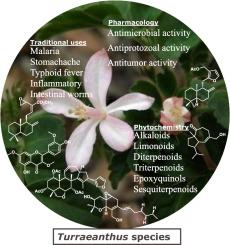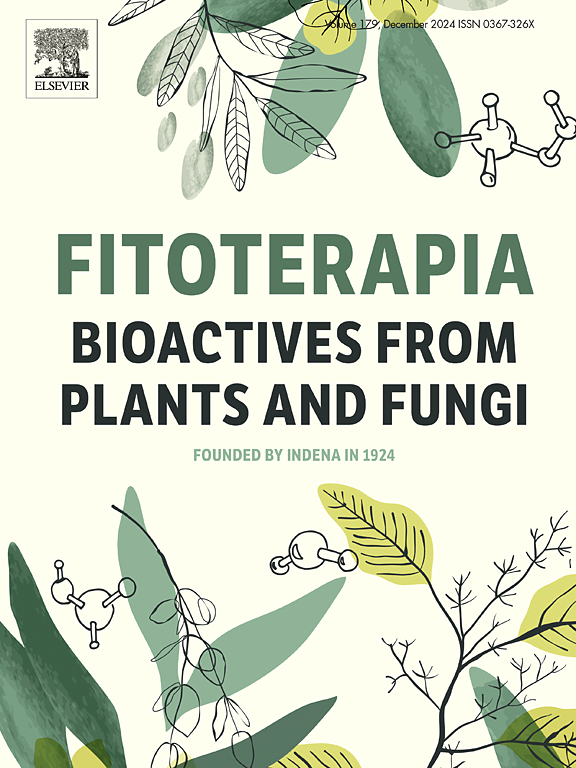Chemical and pharmacological richness of Turraeanthus (Meliaceae): A review on progress and future research opportunities
IF 2.6
3区 医学
Q3 CHEMISTRY, MEDICINAL
引用次数: 0
Abstract
Turraeanthus (Meliaceae) is a genus of trees and shrubs that is widely distributed across tropical and subtropical regions of Africa. Ethnopharmacological studies of this genus suggest that T. africanus is the species most commonly used in traditional medicine to treat various diseases, including malaria, typhoid fever, stomach aches, intestinal worms, coughs and inflammatory and cardiovascular conditions. Previous chemical studies have identified approximately 86 distinct compounds (including 21 synthetic derivatives), with diterpenoids (40.69 %) representing the predominant chemotaxonomic markers in the Turraeanthus genus. Other reported classes of compounds include limonoids (2.32 %), protolimonoids (16.28 %), triterpenoids (3.48 %), sesquiterpenoids (4.65 %), steroids (8.14 %), epoxyquinols (8.14 %), alkaloids (5.81 %), coumarins (4.65 %) and miscellaneous compounds (5.84 %). Some of these isolates have exhibited various bioactivities, including antibacterial, antifungal, toxic, cytotoxic, antiplasmodial and antioxidant effects. This review compiles insights into the traditional uses and chemical and pharmacological aspects of the Turraeanthus genus from 1965 to May 2025. Additionally, it provides a database for UPLC/MSn studies, as well as evidence on the absorption and permeation properties of the isolated compounds from the genus. The data presented were gathered from scientific articles available in online libraries, including Google Scholar, PubMed, Elsevier and SciFinder. The aim of this work is to inspire further research into the rich chemical diversity of Turraeanthus and potentially contribute to the discovery of new therapeutic agents to improve human health.

鸢尾科鸢尾属植物的化学和药理研究进展及展望。
鸢尾是一种乔灌木属,广泛分布于非洲热带和亚热带地区。对这一属的民族药理学研究表明,非洲绦虫是传统医学中最常用于治疗各种疾病的物种,包括疟疾、伤寒、胃痛、肠道蠕虫、咳嗽、炎症和心血管疾病。先前的化学研究已经鉴定出大约86种不同的化合物(包括21种合成衍生物),其中二萜类化合物(40.69 %)代表了Turraeanthus属的主要化学分类标记。其他类化合物的报道包括柠檬苦素类似物(2.32 %),protolimonoids(16.28 %),常用药用(3.48 %)、倍半萜类化合物(4.65 %),类固醇(8.14 %),epoxyquinols(8.14 %)、生物碱(5.81 %),香豆素类(4.65 %)和其他化合物(5.84 %)。其中一些分离物具有多种生物活性,包括抗菌、抗真菌、毒性、细胞毒性、抗疟原虫和抗氧化作用。本文综述了从1965年到2025年5月对Turraeanthus属的传统用途和化学药理方面的见解。此外,它还为UPLC/MSn研究提供了一个数据库,以及从该属中分离的化合物的吸收和渗透特性的证据。所呈现的数据是从包括b谷歌Scholar、PubMed、Elsevier和SciFinder在内的在线图书馆中可获得的科学文章中收集的。这项工作的目的是激发对Turraeanthus丰富的化学多样性的进一步研究,并可能有助于发现新的治疗药物,以改善人类健康。
本文章由计算机程序翻译,如有差异,请以英文原文为准。
求助全文
约1分钟内获得全文
求助全文
来源期刊

Fitoterapia
医学-药学
CiteScore
5.80
自引率
2.90%
发文量
198
审稿时长
1.5 months
期刊介绍:
Fitoterapia is a Journal dedicated to medicinal plants and to bioactive natural products of plant origin. It publishes original contributions in seven major areas:
1. Characterization of active ingredients of medicinal plants
2. Development of standardization method for bioactive plant extracts and natural products
3. Identification of bioactivity in plant extracts
4. Identification of targets and mechanism of activity of plant extracts
5. Production and genomic characterization of medicinal plants biomass
6. Chemistry and biochemistry of bioactive natural products of plant origin
7. Critical reviews of the historical, clinical and legal status of medicinal plants, and accounts on topical issues.
 求助内容:
求助内容: 应助结果提醒方式:
应助结果提醒方式:


